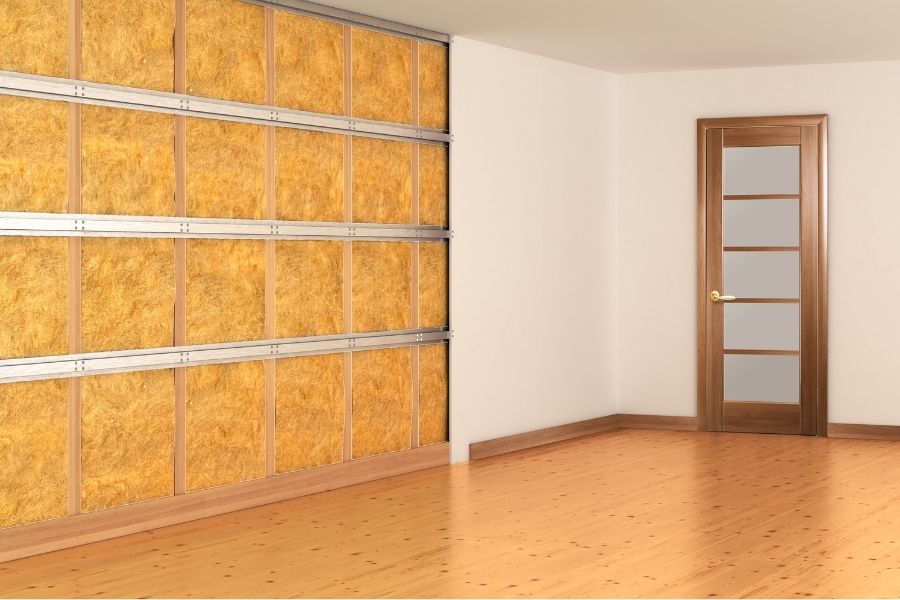How to soundproof a room is a request that is becoming more commonly asked.
With homes being built closer to each other and majority of new homes having lighter weight building material used such as stud frame walls with plasterboard.
Noise levels can get loud.
People want to be able to enjoy their homes without causing friction with their neighbours with noise complaints.
Why People Want Soundproofing
- Theater rooms
- Home Office
- Young Children’s Bedrooms
- Traffic noise or train line
- Under a flight path
- Shift worker
- Musician
A well soundproofed home provides a more harmonious lifestyle it will also add value to your home if you decide to sell.
It will also be more economical to heat and cool.
Soundproofing will mean:
You can enjoy your music or movies at all hours without disturbing others.
Working from home can be done without worrying about disturbing the family or general unwanted noise disturbing your work when you are on a conference call or webinar.
Get It Done In The Initial House Build
The easiest and most cost effective process soundproofing a room is always to do this during the construction period
If you are getting your home built or a renovation constructed – ensure that you request better soundproofing methods and materials to be used.
The most common ones are acoustic plaster , acoustic insulation and mass loaded vinyl
If you are requiring a soundproofed area such as a recording studio this requires some additional planning as it equates to building a room within a room.
What Is Noise
You have to understand that noise is created by sound waves and these can be described as waves of energy and sound can be classed into two type of noise categories:
Airborne sound or Impact noise.
- Airborne sound is just that, sounds transmitted through the air.
Examples are people talking, TV sounds, traffic noise or dogs barking - Impact noise is caused by something hitting a surface within the home.
This is caused by be doors shutting and footsteps on hard flooring.
To stop or reduce sound transmission , we have stop the sound waves or try and reduce the energy/power of the waves
The Basic Overview To Soundproofing
Block – Try and block sound waves from entering an area. This can be double glazed windows, sealing cracks and holes in the walls and using door sweeps to stop sound from coming under a door and around window frames
Absorb and Dampen – They are both very similar. Absorbing means it will ‘soak’ up a sound vibrations – Carpet, cork flooring, acoustic foam or ceiling insulation.
Sound Dampening means it stops the energy wave by not vibrating and letting it continue to travel through it. Like a solid concrete wall or a solid wood door rather than a particle board door.
Decouple – Separating the two sides of a structure so they do not touch and stops the vibrations passing through to each other. It is very effective to isolate the sound on one side of a wall and preventing the sound from passing through to the other side.
Which Rooms Need Soundproofing?
Any room in your house that you think will benefit from it.
If you are building or renovating, having the foresight to add extra noise reduction products. It will add comfort into any home if outside noise is blocked and the home has had acoustic treatment.
Soundproof a Recording Studio
For a professional recording studio or sound booth, you would literally build a ‘room within a room’.
The internal room has no physical connection with the external one, and this is what decoupling refers to. It stops sound vibrations passing through the walls and creating a sound break
Both rooms use dense materials like acoustic plaster board , have acoustic insulation or foam between the walls. The room would be sealed with acoustical caulk to ensure no gaps around the door frame to stop all unwanted sound and external noise
Soundproof a Home Theater Room
When soundproofing a home theater room you do not have to go to the same extreme as you would with a sound recording studio but you would use acoustic plasterboard with resilient mount clips to create a sound energy break between the plasterboard and stud work. Sound absorption with correct good quality carpets and upholstered pieces of furniture will reduce sound echoing.
Soundproof a Home Office:
When you work from home, the last thing you need is unnecessary noises creating a distraction.
Noisy neighbors, noisy kids, people mowing their lawn or a barking dog can be a major distraction and have a negative impact on your productivity.
For a home office, you can take the same steps as with a home theater above.
Soundproof Bedrooms
A bedroom is one space where minimal noise is a must.
Peace and quiet are crucial to a good night’s sleep and when external sounds are minimised your sleep will improve.
To soundproof bedrooms you would usually only require a medium density acoustic insulation batt in the internal walls,and a higher level acoustic insulation batt in the external walls.
Use a draft stop or door sweep on the bedroom door.
What About An Existing Room ?
Typical plasterboard walls are not good for sound reduction, they are thin and the space between the boards and the wall cavity creates an echo chamber and allows sound waves to bounce in the air gap and travel through the wall studs and walls.
Depending on the level of soundproofing required and the budget available, here are the steps we recommend.
To reduce sound bouncing around a room or area, – Think about an open plan home. Using soft furnishings like upholstered furniture, carpets, rugs and blackout curtains or drapes.
These will all help to reduce the transmission of sound waves
Floor coverings will absorb the sound and curtains will help to block the sound coming through the windows.
Option 2
If this is not enough then you can look into adding sound absorbing ceiling tiles and externally mounted sound absorbing acoustic panels to walls.
On the floors, if you were considering adding carpet you can also add acoustic underlay. The extra step with the carpets would help if you lived in an apartment with neighbours below you.
Option 3
If your sound problem is existing noise coming in from outside such as living near a busy road or living close to loud neighbours then you will have to opt for changing your walls and doors. Adding a layer of acoustic plasterboard over an existing wall and replacing hollow doors with a solid core door. Also adding a draft stopper to stop noise coming under the doorway.
Option 4
The next level would be removing the existing plasterboard and fill the wall cavity with acoustic wall insulation and then re plaster with acoustic plasterboard
Option 5
Finally, if the highest level is needed you will have to build sound barrier,like what was described when building a recording studio.
You will need a builder to build a new wall frame that is totally detached from the existing walls. The wall cavities filled with the correct insulation and then acoustic plasterboard used.
Mass loaded vinyl can be used as well.
Remember you will also need to carpet the floors with good quality carpets and acoustic underlay
Professional Advice And Construction
For more advice with how to or what soundproofing material you should use to come up with an effective solution for excess levels of noise and soundproofing ideas
Call Brisbane Plaster Pro
We have experience with all types of soundproofing techniques – acoustic panels, acoustic foam
We would love to be involved in your soundproofing project on an exiting home or be involved with getting it all set up in a new home build.
The post Soundproof Your Home appeared first on Plasterer Brisbane.



